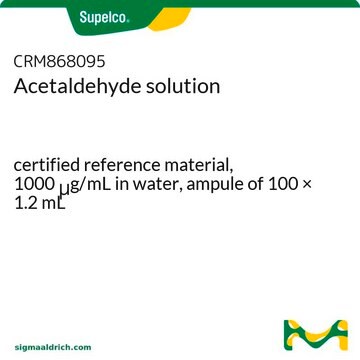About This Item
おすすめの製品
由来生物
synthetic
品質水準
グレード
Kosher
認証
meets purity specifications of JECFA
法規制遵守
meets FCC analytical specification
蒸気密度
1.52 (vs air)
蒸気圧
14.63 psi ( 20 °C)
アッセイ
≥99%
フォーム
liquid
自己発火温度
365 °F
expl. lim.
60 %
屈折率
n20/D 1.332 (lit.)
pH
5 (20 °C)
bp
21 °C (lit.)
mp
−125 °C (lit.)
密度
0.785 g/mL at 25 °C (lit.)
アプリケーション
flavors and fragrances
文書
see Safety & Documentation for available documents
食物アレルゲン
no known allergens
官能
fruity; pungent; ethereal
保管温度
2-8°C
SMILES記法
CC=O
InChI
1S/C2H4O/c1-2-3/h2H,1H3
InChI Key
IKHGUXGNUITLKF-UHFFFAOYSA-N
類似した製品をお探しですか? 訪問 製品比較ガイド
包装
法的情報
免責事項
シグナルワード
Danger
危険有害性情報
危険有害性の分類
Carc. 1B - Eye Irrit. 2 - Flam. Liq. 1 - Muta. 2 - STOT SE 3
ターゲットの組織
Respiratory system
保管分類コード
3 - Flammable liquids
WGK
WGK 3
引火点(°F)
-38.0 °F - closed cup
引火点(℃)
-38.89 °C - closed cup
個人用保護具 (PPE)
Eyeshields, Faceshields, Gloves
適用法令
試験研究用途を考慮した関連法令を主に挙げております。化学物質以外については、一部の情報のみ提供しています。 製品を安全かつ合法的に使用することは、使用者の義務です。最新情報により修正される場合があります。WEBの反映には時間を要することがあるため、適宜SDSをご参照ください。
PRTR
特定第一種指定化学物質
消防法
第4類:引火性液体
特殊引火物
危険等級I
労働安全衛生法名称等を表示すべき危険物及び有害物
名称等を表示すべき危険物及び有害物
労働安全衛生法名称等を通知すべき危険物及び有害物
名称等を通知すべき危険物及び有害物
Jan Code
W200360-771KG-K:
W200360-BULK:
W200360-700LB-K:
W200360-15KG-K:4548174010839
W200360-1KG-K:
W200360-2KG-K:
W200360-771KG:
W200360-170KG:
W200360-VAR:
W200360-1KG:
W200360-170KG-K:
W200360-350LB-K:
W200360-78G-K:
W200360-VAR-K:
W200360-30LB-K:
W200360-682KG-K:
W200360-PZ:
W200360-1.9KG-K:4548174010822
W200360-BULK-K:
W200360-682KG:
W200360-SAMPLE-K:
W200360-700LB:
W200360-100ML-K:
W200360-350LB:
この製品を見ている人はこちらもチェック
ライフサイエンス、有機合成、材料科学、クロマトグラフィー、分析など、あらゆる分野の研究に経験のあるメンバーがおります。.
製品に関するお問い合わせはこちら(テクニカルサービス)






